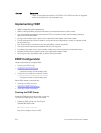19
Force10 Resilient Ring Protocol (FRRP)
Force10 resilient ring protocol (FRRP) provides fast network convergence to Layer 2 switches
interconnected in a ring topology, such as a metropolitan area network (MAN) or large campuses.
FRRP is similar to what can be achieved with the spanning tree protocol (STP), though even with
optimizations, STP can take up to 50 seconds to converge (depending on the size of network and node
of failure) may require 4 to 5 seconds to reconverge. FRRP can converge within 150ms to 1500ms when a
link in the ring breaks (depending on network configuration).
To operate a deterministic network, a network administrator must run a protocol that converges
independently of the network size or node of failure. FRRP is a proprietary protocol that provides this
flexibility, while preventing Layer 2 loops. FRRP provides sub-second ring-failure detection and
convergence/re-convergence in a Layer 2 network while eliminating the need for running spanning-tree
protocol. With its two-way path to destination configuration, FRRP provides protection against any single
link/switch failure and thus provides for greater network uptime.
Protocol Overview
FRRP is built on a ring topology.
You can configure up to 255 rings on a system. FRRP uses one Master node and multiple Transit nodes in
each ring. There is no limit to the number of nodes on a ring. The Master node is responsible for the
intelligence of the Ring and monitors the status of the Ring. The Master node checks the status of the
Ring by sending ring health frames (RHF) around the Ring from its Primary port and returning on its
Secondary port. If the Master node misses three consecutive RHFs, the Master node determines the ring
to be in a failed state. The Master then sends a Topology Change RHF to the Transit Nodes informing
them that the ring has changed. This causes the Transit Nodes to flush their forwarding tables, and re-
converge to the new network structure.
One port of the Master node is designated the Primary port (P) to the ring; another port is designated as
the Secondary port (S) to the ring. In normal operation, the Master node blocks the Secondary port for all
non-control traffic belonging to this FRRP group, thereby avoiding a loop in the ring, like STP. Layer 2
switching and learning mechanisms operate per existing standards on this ring.
Each Transit node is also configured with a Primary port and a Secondary port on the ring, but the port
distinction is ignored as long as the node is configured as a Transit node. If the ring is complete, the
Master node logically blocks all data traffic in the transmit and receive directions on the Secondary port
to prevent a loop. If the Master node detects a break in the ring, it unblocks its Secondary port and allows
data traffic to be transmitted and received through it. Refer to the following illustration for a simple
example of this FRRP topology. Note that ring direction is determined by the Master node’s Primary and
Secondary ports.
368
Force10 Resilient Ring Protocol (FRRP)


















